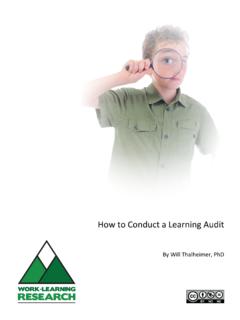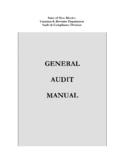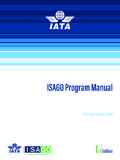Transcription of The Training Audit Program - Mr. PBET
1 The Training Audit Program Not sure whether you have successfully implemented PBET at your site? Not sure whether you have successfully PBET-ized an existing course? Think that your organization already follows the PBET. standards? You can invite Solid Performance Solutions to come to your site and perform an Audit of one course, one lesson, or your whole Program . ! The Audit includes a review of your materials and a site visit. The site visit includes class observations and interviews with trainers and developers. ! The Audit concludes with your choice of a) an informal letter summarizing the positive aspects of your Program together with a list of any recommendations, and/or b) if appropriate, a formal letter certifying that the Audit found the course and Program to be in compliance with PBET standards.
2 An Audit can help by providing an outside, objective review of your Training . In turn, this can help by providing Training organizations ! recommendations to bring existing programs up to PBET standards. ! certification of existing programs or courses to demonstrate to customers that PBET standards have been met. How the Program Works The Program begins with a thorough discussion of what exactly you want to include in the Audit . All of the details are agreed upon in an Agreement. Typically, Solid Performance Solutions (SPS) provides a list of materials for the Program owner to supply in advance. The list for one course may well include: !
3 A hierarchy, map, or outline for the course ! All of the course objectives. ! A copy of all student handouts provided in the course, including participant guides, manuals, lab sheets, tests, exercises, and/or course directions. Then, arrangements are made for SPS to observe, on location, three to six sample lessons. These lessons are chosen jointly by SPS and the Program owner. NOTE: SPS does not sit through and observe the entire course, just selected lessons. Following the observation, SPS will interview the trainer(s) and course developer(s) (if the developer and trainer are not the same person). Not later than ten days following the site visit, SPS will provide a Training Course Audit Report to the individual indicated in the Agreement.
4 Page 1. The Audit Report includes: ! an evaluation against each of the PBET Criteria (see below). ! a summary of every part of the Training course that qualifies as performance-based Training ! a list of action item suggestions, where applicable, for modifying the course to conform to the PBET Criteria. ! a statement of PBET Certification, if applicable. NOTE: SPS does not evaluate the technical accuracy of course content. Program Arrangements and Costs ! The Program fee is based loosely on the expected length of the course to be evaluated plus travel expenses. An example: An Audit of a typical 5 day basic maintenance course with about 25 lesson modules would cost $3,500 plus travel expenses.
5 ! An Agreement will detail all of the services and charges. It will also specify that 65% of the total fee is to be paid in advance; the remainder within 30 days of the submission of the Training Course Audit Report. For further information on this Program , contact Solid Performance Solutions. PBET Criteria and a Self- Audit A checklist of PBET Criteria is attached on the next page. When SPS audits a Program or course, it does so on the basis of the checklist. Consequently, those requesting SPS to Audit their Program or specific courses might begin by conducting a self- Audit . This checklist is also available at the end of the PBET Workshop Participant Guide.
6 Those who have completed the Workshop may likely best understand each line item of the checklist. Richard Goutal 17 Desmond Avenue Manchester, MA 01944 USA. T: +978-526-4020 F: +978-526-2427. W: Page 2. PBET Criteria for Evaluation of Training programs and Courses Development Process A Task List was created and validated from analysis of performer(s) job(s). Task detailings were derived from analysis and are provided to course participants for each task (as a procedure or as one or more job aids see Support Materials). All or most lessons of the course were piloted and adjusted as required. An ongoing evaluation plan is in place that emphasizes performance results.
7 Objectives There is a list of course performance objectives and it is based on the Task List (above), and thus the course of objectives is complete and valid for the trainee(s). All objectives have valid conditions and standards. All objectives are worded clearly and avoid common errors (see pg Analyze-4-19). Course Map There is a course map with proper sequencing for all course objectives. The course has no missing enabling skills. The course map has adequate horizontals (built-in flexibility) for meeting individual differences. There is a course prerequisites list; each prerequisite is stated as a performance. Individual Lessons (Modules) for Each Objective There is a Lesson Planning Form (LPF) for each lesson on the Course Map.
8 Each LPF has enough detail so that a technically competent instructor can understand what should be said and done at each part of the lesson. All students are checked for competency on each objective with a skill test. Each skill check is valid and fair (matches the objective's standards and conditions), and if the objective calls for a hands-on test, that is what is used. The opportunity for practice is provided for each skill and sub-skill (if any). Each practice activity has a plan for intermediate and final feedback. All of the content is relevant to the lesson objective. At least 10% of all LPFs provide alternate teaching methods for all or part of the lesson to enable flexibility to meet individual differences.
9 Support Materials There is a sign-off sheet which lists all of the course objectives in short-form. There is a written procedure or job aid for every task on the Task List. Each written procedure is accurate (it works) and clear (can be followed without confusion or wasted time). Each written procedure is the best way for doing it (based on comparative study, the procedure provided is the BKM). Each job aid (for examples: flow chart, block diagram) is accurate (it works) and clear (can be followed without confusion or wasted time). In addition to the equipment manual(s) [that is, procedure book(s)], there is a Training Manual with a chapter for each lesson in the course.
10 Each chapter follows the guidance on pg Develop-1-8. Course Delivery (Based on Sample Modules). Instructor introduces lesson by reading objective and telling about the test plan. Instructor followed the content delivery plan, without adding irrelevant material. Instructor allowed adequate time for practice so that repeated or supplementary practice was afforded until mastery of the objective was achieved. Instructor applied appropriate principles of feedback during practice and at other times when appropriate. Instructor used the skill check appropriately. Instructor promoted an atmosphere of comfort, not anxiety or frustration. Individual differences were skillfully managed.






